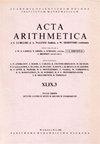Diophantine approximation with constraints
IF 0.5
3区 数学
Q3 MATHEMATICS
引用次数: 1
Abstract
Following Schmidt, Thurnheer and Bugeaud-Kristensen, we study how Dirichlet's theorem on linear forms needs to be modified when one requires that the vectors of coefficients of the linear forms make a bounded acute angle with respect to a fixed proper non-zero subspace $V$ of $\mathbb{R}^n$. Assuming that the point of $\mathbb{R}^n$ that we are approximating has linearly independent coordinates over $\mathbb{Q}$, we obtain best possible exponents of approximation which surprisingly depend only on the dimension of $V$. Our estimates are derived by reduction to a result of Thurnheer, while their optimality follows from a new general construction in parametric geometry of numbers involving angular constraints.带约束的丢番图近似
继Schmidt、Thurnheir和Bugeaud-Kristensen之后,我们研究了当要求线性形式的系数向量相对于$\mathbb{R}^n$的固定的适当非零子空间$V$形成有界锐角时,如何修改线性形式上的狄利克雷定理。假设我们正在近似的$\mathbb{R}^n$的点在$\mathbb{Q}$上具有线性无关的坐标,我们获得了最佳可能的近似指数,该指数令人惊讶地仅取决于$V$的维数。我们的估计是通过简化为Thurnher的结果得出的,而它们的最优性来自于涉及角度约束的数的参数几何中的一个新的一般构造。
本文章由计算机程序翻译,如有差异,请以英文原文为准。
求助全文
约1分钟内获得全文
求助全文
来源期刊

Acta Arithmetica
数学-数学
CiteScore
1.00
自引率
14.30%
发文量
64
审稿时长
4-8 weeks
期刊介绍:
The journal publishes papers on the Theory of Numbers.
 求助内容:
求助内容: 应助结果提醒方式:
应助结果提醒方式:


